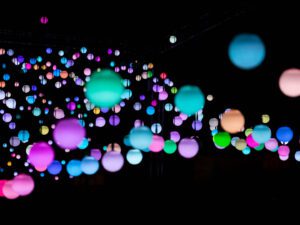Daan Roosegaarde (b. 1979) works at the threshold of science, art and engineering – producing extraordinary large-scale interventions in public spaces. Many of his creations are designed to tackle our current ecological crises. For the Smog Free Project, for example, Roosegaarde and his team installed giant smog-filtering towers in urban locations, converting the gathered carbon particles in diamonds. Their Space Waste Lab, meanwhile, is working on innovative ways to track and capture space junk, including using light beams to trace it across the night sky. For Roosegaarde’s latest project, Urban Sun, the artist has teamed up with designers, scientists and engineers to develop a public lighting system that bathes outdoor spaces in virus-destroying UVC rays. It’s a novel and beautiful way of bolstering government defences against the spread of coronavirus.
A: Urban Sun harnesses the power of far-UVC light to provide an outdoor space in which people can meet more safely during the Coronavirus pandemic. Can you explain the concept behind the project?
DR: Through the emission of a specific light at precisely 222 nanometres, air and surfaces within the light circle are cleansed of viruses, including coronavirus. Urban Sun is a way of visualising hope—it should also make community events safer. I was inspired by the powerful light of the sun, which supports all life on Earth. With the onset of the pandemic, our world suddenly became filled with plastic barriers, warning stickers and social distancing. I asked myself how we could clean our cities of Covid-19, and how light could help to restore safer encounters in public spaces. I read about a wavelength of far-UVC light at 222nm that can kill viruses whilst remaining safe for humans and animals. It’s about inspiring hope and creating spaces for us to renew our connection to one another—though of course, Urban Sun should always be used as an additional layer of protection to any government rules.

A: Do you think that your project will inspire governments and public institutions to look into the possible uses of far-UVC?
DR: The light of Urban Sun is 4.6 billion years old, as it is in the light of the sun. But the earth’s atmosphere filters it away. It was only in 2018 that the first scientific paper regarding the potential uses of far-UVC was published, although traditional UV has been used for more than 80 years. The industry describes 222nm UV as “new,” since the science community only began evaluating its possible uses in 2018. Nowadays, 222nm lights can be ordered online—they are smaller and much less powerful indoor lamps. But Urban Sun is pioneering the use of 222nm light in outdoor public spaces.
Urban Sun is meant to serve as a call to action to governments and partners to speed up further applications of the technology. A lot of my work is about exploring the boundaries of what we can do with new scientific innovations. I am open to new collaborations and research opportunities and I hope Urban Sun will create safer spaces all over the world.

A: Do you see Urban Sun as an art project, a public design project, a scientific project, or a combination of all of these? Can you explain how aesthetic, ergonomic and scientific concerns merge in the work?
DR: All my work explores the relation between people, technology and space. I am fascinated with nature and technology and this influences my designs. Urban Sun is a living lab project set up by Studio Roosegaarde involving universities, engineers, designers and partners from the world of technology. The idea is to synthesise creative perspectives and scientific methodology, with the ultimate goal of bringing back public well-being and safety by reducing the presence of coronavirus in public spaces.
Cooperation is vital to success, which is why Studio Roosegaarde is working with researchers and scientists. The technology has also been measured and calibrated by the Dutch National Meteorology Institute. The aim of the project is to pair design with science, whilst also acknowledging the emotions involved in the struggle to preserve public spaces and events for social interactions.

A: When and where did Urban Sun launch, and do you have plans for new versions of the work to be installed around the world?
DR: Urban Sun’s initial launch took place alongside the Erasmus Bridge in Rotterdam on March 2 2021, but the project also debuted as a movie premiere, and at the moment we are ready for exhibitions. We are also busy with a 3,500-square-metre version of Urban Sun. The basic design can be scaled up even beyond this—although the technical simulation shows a public square of 100m2 by 3,500m2, a larger space could be covered.
A: How can you imagine the technology and aesthetics of Urban Sun being used in future?
DR: We want to tour around the world with Urban Sun. My dream would be to have an exhibition at the Olympics in Tokyo! They already showed interest in the project.
A: What do you think will be the role of science solving the multiple ecological catastrophes we are living through?
DR: We should not be scared, but curious about our future. Combining design and science can create a real impact.
Find out more here.
Words: Greg Thomas
Images courtesy Studio Roosegaarde.





